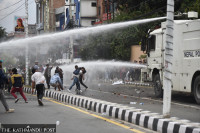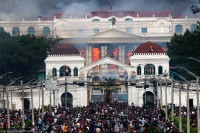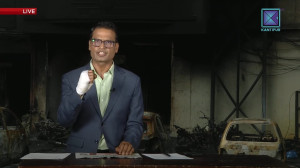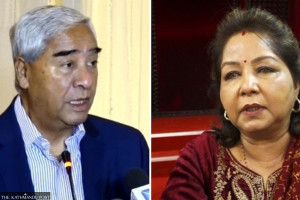Opinion
A heritage flashpoint
Controversy over rebuilding of Rani Pokhari may become case study in handling of significant cultural heritage in Kathmandu
David N Gellner
The ongoing controversy over the reconstruction of Rani Pokhari in the heart of Kathmandu has pitted the newly elected Mayor of Kathmandu, Bidya Sundar Shakya, of the UML, against his Deputy Mayor, Hari Prabha Khadgi, of the Nepali Congress Party. It has also pitted the young against the old, competing definitions of heritage conservation against each other, purists against pragmatists, possibly Newar against Khas, and certainly one Newar against another. The role of the Department of Archaeology remains obscure.
It is worth reminding ourselves just why the city landscapes of the Kathmandu Valley are so highly valued and why the whole valley is a UNESCO World Heritage Site, with seven designated monument zones within it (the three palace squares of Kathmandu, Bhaktapur, and Patan, Swayambhu, Bouddha (Khasti), Pasupatinath, and Changu Narayan). The Valley is the guardian of a form of Hindu-Buddhist urban civilisation that once spread across the whole of South Asia and beyond as far as the Indonesian island of Bali. Its scriptures and liturgies were in Sanskrit, its townscapes were a harmonious mix of row houses, courtyards, ponds, gardens, sunken water spouts (providing running water, often brought underground from many kilometres away), and temples. The temples were usually at crossroads or town squares, the pre-eminent sites of the festival occasions. Many of the courtyards were sacred Buddhist sites, formerly the homes of Buddhist monks, now inherited by the Shakyas and Bajracharyas, a Buddhist caste of householder monks and artisans. Many years ago the numerous courtyards of Patan/Lalitpur reminded David Snellgrove of the religio-monastic cities of Oxford and Cambridge.
Multi-faceted celebration
Robert Levy, in his monumental book, Mesocosm, called the annual round of festivals in Bhaktapur a “civic ballet”. The city’s Newar inhabitants play out the drama of their communal religion in the city’s squares, which form a stage where their deepest concerns and strongest ties can be dramatised. Gérard Toffin, the most prolific anthropologist of the Newars, showed in his 2010 monograph, Le Fête-Spectacle, a detailed historical and anthropological analysis of Indra Jatra, that public festivals are multi-sided (and multi-sited) performances encompassing dance, music, spectacle, as well as specified food and drink, in which the local community is both participant and audience. Toffin also showed how festivals are, both in South Asia generally and more specifically in the Kathmandu Valley, the source of plays and dramas that were originally performed in the street and on raised platforms (dabu) in city squares and only later translated to theatres and other indoor spaces. The indigenous theatrical tradition has its origin in ritual and religious performance.
In the words of UNESCO, copied by many tourist websites: “The cultural traditions of the multi ethnic people who settled in this remote Himalayan valley over the past two millennia, referred to as the Newars, is manifested in the unique urban society which boasts of one of the most highly developed craftsmanship of brick, stone, timber and bronze in the world. The coexistence and amalgamation of Hinduism and Buddhism with animist rituals and Tantrism is considered unique.”
The magic of the Kathmandu Valley—which will keep tourists coming, when international airports become available in Pokhara, Lumbini, and Nijgadh that will enable them to avoid it—depends on preserving as much of this heritage as possible. It means preserving not just the monument zones, but also the intangible cultural heritage that underlies them. ‘Intangible cultural heritage’ is UNESCO-speak for the continually recreated and handed-on traditions that keep these designated monument zones so excitingly vital, and prevent them from becoming (as so many such zones in other countries are) just empty husks, reminders of a vanished way of life.
Intangible cultural heritage is a very Asian concept (owing much to the Japanese tradition of honouring its top artists and artisans as ‘living cultural treasures’). It locates heritage and culture less in physical objects and more in the skills and knowledge of those who know how to pass it on. This includes artisan knowledge, such as carpentry, god-making, mask-making, pottery, gold- and silver-smithing, bronze and copper making, and so on, for which the Newars are famous throughout the Himalayas and beyond (e.g. Tibet and China). But it is also the formal and informal knowledge that keeps the rituals, dances, and festivals happening year after year.
Inadequate promotion
So far, Nepal has not a single item of intangible cultural heritage inscribed on UNESCO’s list. That list was initiated in 2008, following the 2003 Convention for the Safeguarding of the Intangible Cultural Heritage, with new items added each year. China leads the world with 39 items, India has 13 (including the Kumbh Mela, copper utensil making in Punjab, Buddhist chanting in Ladakh, Kalbelia folk songs and dancing of Rajasthan, and Vedic chanting). Bangladesh has four items and Pakistan two. Even Bhutan has managed one item (masked dance and drumming from Drametse). Nepal has precisely zero. That can only be due to the incapacity of the Nepali state to introduce the necessary structures and fill out the application forms. This is a disappointing failure on the part of the Ministry of Culture, Tourism, and Civil Aviation.
The living culture of the Kathmandu Valley is a source of pride and identity, and a vital source of revenue, for the entire country. If it is to survive, there has to be a presumption that local communities will be involved in heritage preservation and that traditional artisans and techniques will be employed to reconstruct key sites. What has particularly raised the ire of the activists who padlocked the site in protest is the insensitive use of concrete, both to build the boundary wall and to line the pond, when alternative traditional techniques are easily available.
Some compromise must surely be possible. Ideally it would recognise (1) that in the past the traditions of the Valley were far from static and were always open to the incorporation of new techniques and styles; (2) that local stakeholders have a right to access and input into the way heritage sites are managed and reconstructed; (3) that public access to Rani Pokhari, which has been largely restricted for so many years, would be good; (4) that, while ‘Newar heritage’ should not be fetishised or essentialised, inherited artisan skills should be made use of and incorporated into reconstruction to the maximum extent possible.
The controversy over the rebuilding of, and opening access to, Rani Pokhari may become a case study in the handling of significant cultural heritage in Kathmandu. It may also become a case study in the kinds of conflict that are likely to arise under the new governance structures that Nepal is going to have to get used to operating over the coming years. Let us hope that it is not held up in future as an example of how not to do conservation.
- Gellner is Professor of Social Anthropology, University of Oxford, UK




 18.95°C Kathmandu
18.95°C Kathmandu










